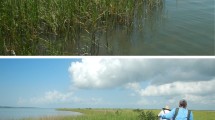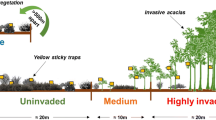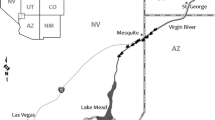Abstract
Bitou bush (Chrysanthemoides monilifera ssp. rotundata) is a major environmental weed of littoral habitats on the southeastern coast of Australia. This study investigates the impacts upon selected arthropod assemblages of habitat invasion by this weed. Sixteen sites were placed at four geographic localities within nature reserves between Forster and Budgewoi on the coast of New South Wales. The sampling design included two spatial scales (between and within localities) and eight repeat samples (taken at two scales of temporal separation). Arthropods were collected from both arboreal and epigaeic micro-habitats. Specimens of ants (Hymenoptera: Formicidae), beetles (Coleoptera), true bugs (Heteroptera) and spiders (Araneae) were identified to species level. Differences in α diversity and species abundance distributions between the taxonomic assemblages are described, along with comparisons of data contrasts between bitou bush-free (“control”) and bitou bush-invaded (“impact”) habitats and between geographic localities. A subsidiary impact associated with herbicide application for control of the weed is also examined. Analysis of environmental differences indicates that bitou bush acts as a dampening agent, reducing the degree of seasonal fluctuation in factors such as leaf litter cover. Arboreal Heteroptera were the only group to show consistent evidence of significant differences in taxon richness or abundance between control and impact treatments within a locality, seen as a disruption of normal seasonal variation in diversity in bitou bush-impacted sites. Significant differences between geographic localities were more common, suggesting an effect at broader spatial scales. Evidence for arthropod assemblages characteristic of specific vegetation types was detected for several groups, as were changes in arthropod assemblage composition following application of herbicide for bitou bush control.








Similar content being viewed by others
References
Agriculture & Resource Management Council of Australia & New Zealand (ARMCANZ), Australian & New Zealand Environment & Conservation Council and Forestry Ministers (ANZECCFM) (2000) Weeds of national significance bitou bush and boneseed (Chrysanthemoides monilifera ssp. rotundata and monilifera) strategic plan. National Weeds Strategy Executive Committee, Launceston
Andersen AN (1995) A classification of Australian ant communities, based on functional groups which parallel plant life-forms in relation to stress and disturbance. J Biogeogr 22:7–14
Anderson MJ (2003) DISTLM v.2: A FORTRAN computer program to calculate a distance-based multivariate analysis for a linear model. Department of Statistics, University of Auckland, Auckland NZ
Anderson MJ, Gribble NA (1998) Partitioning the variation among spatial, temporal and environmental components in a mutivariate data set. Austr J Ecol 23:158–167
Anderson MJ, Willis TJ (2003) Canonical analysis of principal coordinates: a useful method of constrained ordination for ecology. Ecology 84:511–525
Basset Y (1992) Host specificity of arboreal and free-living insect herbivores in rain forests. Biol J Linn Soc 47:115–133
Bell JR, Haughton AJ, Boatman ND, Wilcox A (2002) Do incremental increases of the herbicide glyphosate have indirect consequences for spider communities? J Arachnol 30:288–297
Bohac J (1999) Staphylinid beetles as bioindicators. Agric Ecosyst Environ 74:357–372
Borcard D, Legendre P, Drapeau P (1992) Partialling out the spatial component of ecological variation. Ecology 73(3):1045–1055
Chao A, Lee S-M (1992) Estimating the number of classes via sample coverage. J Am Stat Assoc 87:210–217
Coleman BD (1981) On random placement and species–area relations. Math Biosci 54:191–215
Colwell RK (1997) EstimateS: Statistical estimation of species richness and shared species from samples. Version 5. User’s Guide and application published at: http://viceroy.eeb.uconn.edu/estimates
Colwell RK, Coddington JA (1994) Estimating terrestrial biodiversity through extrapolation. Philos Trans Roy Soc Lond Ser B 345:101–118
Dodkin MJ, Gilmore AJ (1984) Species and ecosystems at risk. In: Love A, Dyason R (eds) Bitou bush and boneseed: a national conference on Chrysanthemoides monilifera. NSW Government, pp 33–52
Doing H (1985) Coastal fore dune zonation and succession in various parts of the world. Vegetatio 61:65–75
Duelli P, Obrist MK, Schmatz DR (1999) Biodiversity evaluation in agricultural landscapes: above-ground insects. Agric Ecosyst Environ 74:33–64
Faith DP, Minchin PR, Belbin L (1987) Compositional dissimilarity as a robust measure of ecological distance. Vegetatio 69:57–68
Fox BJ, Fox MD, Taylor JE, Jackson GP, Simpson J, Higgs P, Rebec L, Avery R (1996) Comparison of regeneration following burning, clearing or mineral sand mining at Tomago, NSW: I. Structure and growth of the vegetation. Austr J Ecol 21:184–199
French K, Eardley K (1997) The impact of weed infestations on litter invertebrates in coastal vegetation. In: Klomp N, Lund I (eds) Frontiers in ecology: building the links. Elsevier Science, pp 89–102
French K, Major RE (2001) Effect of an exotic Acacia (Fabaceae) on ant assemblages in South African fynbos. Austral Ecol 26:303–310
Glasby TM (1997) Analysing data from post-impact studies using asymmetrical analyses of variance: a case study of epibiota on marinas. Austr J Ecol 22:448–459
Gotelli NJ, Colwell RK (2001) Quantifying biodiversity: procedures and pitfalls in the measurement and comparison of species richness. Ecol Lett 4:379–391
Green RH (1989) Power analysis and practical strategies for environmental monitoring. Environ Res 50:195–205
Green RH (1993) Application of repeated measures designs in environmental impact and monitoring studies. Austr J Ecol 18:81–98
Greenstone MH (1984) Determinants of web spider species diversity: vegetation structural diversity vs. prey availability. Oecologia 62:299–304
Heyligers PC (1984) The impact of introduced plants on foredune formation in south-eastern Australia. Proc Ecol Soc Austr 14:23–41
Hitchcock P (1984) The conservation programme for the New South Wales coast. In: Love A, Dyason R (eds) Bitou bush and boneseed: a national conference on Chrysanthemoides monilifera. NSW Government, pp 11–32
Hölldobler B, Wilson EO (1990) The ants. Belknap Press, Cambridge MA
Jones CG, Lawton JH, Shachak M (1994) Organisms as ecosystem engineers. Oikos 69:373–386
Kim KC (1993) Biodiversity, conservation and inventory: why insects matter. Biodivers Conserv 2:191–214
Lawton JH (1983) Plant architecture and the diversity of phytophagous insects. Annu Rev Entomol 28:23–39
Lawton JH (1994) What do species do in ecosystems? Oikos 71:367–374
Legendre P (1990) Quantitative methods and biogeographic analysis. In: Garbary DJ, South GR (eds) Evolutionary biogeography of the marine algae of the North Atlantic. Springer-Verlag, Berlin, pp 9–34
Legendre P, Legendre L (2003) Numerical ecology, 2nd edn. Elsevier Press, Amsterdam
Louda SM, Potvin MA (1995) Effect of inflorescence-feeding insects in the demography and lifetime fitness of a native plant. Ecology 76:229–245
Louda SM, Rand TA (2003) Native thistles: expendable or integral to ecosystem resistance to invasion? In: Karieva P, Levin SA (eds) The importance of species. Princeton U. Press, Princeton, pp 5–15
Majer JD (1990) Rehabilitation of disturbed land: long-term prospects for the recolonization of fauna. Proc Ecol Soc Austr 16:509–519
Marc P, Canard A (1997) Maintaining spider biodiversity in agroecosystems as a tool in pest control. Agric Ecosyst Environ 62:229–235
Marc P, Canard A, Ysnel F (1999) Spiders (Araneae) useful for pest limitation and bioindication. Agric Ecosyst Environ 74:229–273
Maron JL, Combs JK, Louda SM (2002) Convergent demographic effects of insect attack on related thistles in coastal vs. continental dunes. Ecology 83:3382–3392
McLachlan A, Jaramillo E (1995) Zonation on sandy beaches. Oceanogr Marine Biol Annu Rev 33:305–335
Myerscough PJ, Carolin RC (1986) The vegetation of the Eurunderee sand mass, headlands and previous islands in the Myall Lakes area, New South Wales. Cunninghamia 1:399–466
Neser S, Morris MJ (1984) Preliminary observations on natural enemies of Chrysanthemoides monilifera in South Africa. In: Love A, Dyason R (eds) Bitou bush and boneseed: a national conference on Chrysanthemoides monilifera. NSW Government, pp 105–110
New South Wales National Parks & Wildlife Service (2000) NSW Bitou Bush Strategy. NSW NPWS, Sydney
Nicholls W (1984) Bitou bush, boneseed and the Australian heritage. In: Love A, Dyason R (eds) Bitou bush and boneseed: a national conference on Chrysanthemoides monilifera. NSW Government, pp 7–10
Palmer MW (1990) The estimation of species richness by extrapolation. Ecology 71:1195–1198
Peeters PJ, Read J, Sanson GD (2001) Variation in the guild composition of herbivorous insect assemblages among co-occurring plant species. Austral Ecol 26(4):371–384
Rieux R, Simon S, Defrance H (1999) Role of hedgerows and ground cover management on arthropod populations in pear orchards. Agric Ecosyst Environ 73:119–127
Rypstra AL, Carter PE, Balfour RA, Marshall SD (1999) Architectural features of agricultural habitats and their impact on the spider inhabitants. J Arachnol 27:371–377
Siemann E (1998) Experimental tests of effects of plant productivity and diversity on grassland arthropod diversity. Ecology 79:2057–2070
Siemann E, Tilman D, Haarstad J, Ritchie M (1998) Experimental tests of the dependence of arthropod diversity on plant diversity. Am Natural 152(5):738–750
Slobodchikoff CN, Doyen JT (1977) Effects of Ammophila arenaria on sand dune arthropod communities. Ecology 58:1171–1175
Southwood TRE, Brown VK, Reader PM (1979) The relationships of plant and insect diversities in succession. Biol J Linn Soc 12:327–348
Specht RL (ed) (1979) Ecosystems of the world Volume 9A: Heathlands and related shrublands. Descriptive studies. Elsevier Scientific Publishing Co., Amsterdam
Spence JR, Niemelä JK (1994) Sampling Carabid assemblages with pitfall traps: the madness and the method. Can Entomol 126:881–894
Stork NE, Hammond PM (1997) Sampling arthropods from tree-crowns by fogging with knockdown insecticides: lessons from studies of oak tree beetle assemblages in Richmond Park (UK). In: Stork NE, Adis J, Didham RK (eds) Canopy arthropods. Chapman and Hall, London, pp 3–26
ter Braak CJF, Verdonschot PFM (1995) Canonical correspondence analysis and related multivariate methods in aquatic ecology. Aquat Sci 57:255–289
ter Braak CJF, Šmilauer P (1998) CANOCO reference manual and user’s guide to CANOCO for Windows: software for canonical community ordination (version 4). Microcomputer Power Ithaca, NY, USA, 352 pp
Thatcher AC, Westman WE (1975) Succession following mining on high dunes of coastal southeast Queensland. In: Kikkawa J, Nix HA (eds) Managing terrestrial ecosystems, 9th edn., pp 17–31
Uetz GW (1991) Habitat structure and spider foraging. In: Bell SS, McCoy ED, Mushinsky HR (eds) Habitat structure: the physical arrangement of objects in space. Chapman & Hall, London, pp. 325–248
Underwood AJ (1992) Beyond BACI: the detection of environmental impacts on populations in the real, but variable, world. J Exp Mar Biol Ecol 161:145–178
Underwood AJ (1993) The mechanics of spatially replicated sampling programmes to detect environmental impacts in a variable world. Austr J Ecol 18:99–116
Underwood AJ (1994) Things environmental scientists (and statisticians) need to know to receive (and give) better statistical advice. In: Fletcher DJ, Manly BJ (eds) Statistics in ecology and environmental monitoring. University of Otago Press, Dunedin NZ, pp 33–61
Varchola JM, Dunn JP (1999) Changes in ground beetle (Coleoptera: Carabidae) assemblages in farming systems bordered by complex or simple roadside vegetation. Agric Ecosyst Environ 73:41–49
Webb CE, Oliver I, Pik AJ (2000) Does coastal foredune stabilization with Ammophila arenaria restore plant and arthropod communities in southeastern Australia? Restor Ecol 8:283–288
Weiss PW (1984a) Seed characteristics and regeneration of some species in invaded coastal communities. Austr J Ecol 9:99–106
Weiss PW (1984b) The invasiveness of Chrysanthemoides monilifera. In: Love A, Dyason R (eds) Bitou bush and boneseed: a national conference on Chrysanthemoides monilifera. NSW Government, pp 83–87
Wilkie L, Cassis G, Gray M (2003) A quality control protocol for terrestrial invertebrate biodiversity assessment. Biodivers Conserv 12:99–106
Woodroffe CD (2002) Coasts: form, process and evolution. Cambridge University Press, Cambridge, UK
Acknowledgements
This study was funded by the Environmental Research Trust (ref 95/RD/G02). Field sites were selected with the cooperation of the New South Wales National Parks and Wildlife Service and the NSW Department of Agriculture. In particular, the authors would like to acknowledge the efforts of those who participated in the field collection and laboratory sorting. They include: Kim Debbidge, Edith Donald, Michael Elliott, Rebecca Harris, Cate LeMann, Sarah Napoli, Annie Noack, Nicola Saltman, Helen Smith and Melissa Whitfield. Thanks also to Chris Reid, Roger de Keyser and Elizabeth Jeffreys for assisting with quality control of the Coleoptera and Formicidae. Gareth Carter provided invaluable assistance with statistical analysis. Finally, thanks to Dieter Hochuli, Kris French, Paul Downey and two anonymous reviewers for providing valuable comments on earlier drafts of the manuscript.
Author information
Authors and Affiliations
Corresponding author
Rights and permissions
About this article
Cite this article
Wilkie, L., Cassis, G. & Gray, M. The effects on terrestrial arthropod communities of invasion of a coastal heath ecosystem by the exotic weed bitou bush (Chrysanthemoides monilifera ssp. rotundata L.). Biol Invasions 9, 477–498 (2007). https://doi.org/10.1007/s10530-006-9055-z
Received:
Accepted:
Published:
Issue Date:
DOI: https://doi.org/10.1007/s10530-006-9055-z




